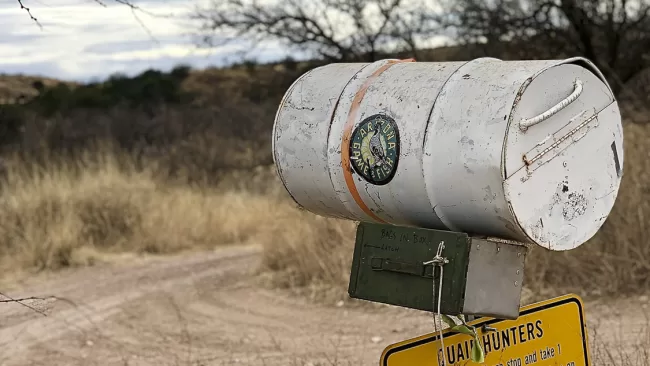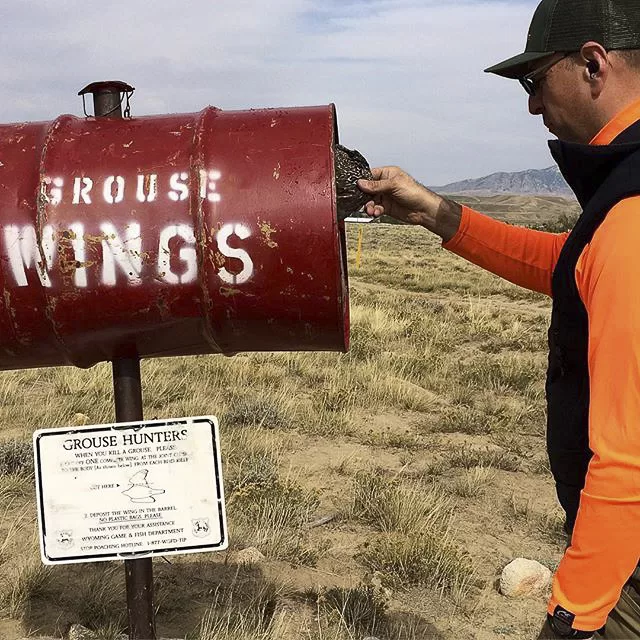Just Wing It
By Edgar Castillo
Voluntary wing deposits help shape the future of upland birds and waterfowl
We had stopped momentarily, as I had observed the red barrel far off in the distance as we drove down from the sage flats. I exited the truck and went towards the back. I could see the spiny tail feathers protruding from my orange bird vest as they swayed gently in the wind. I reached for the vest and immediately felt its heft. The sage grouse is North America’s largest grouse. The bird derives its name, food, and shelter from the sagebrush on which it depends for its very life. The wavering smell of sage encompassed my surroundings and clung to my clothes.
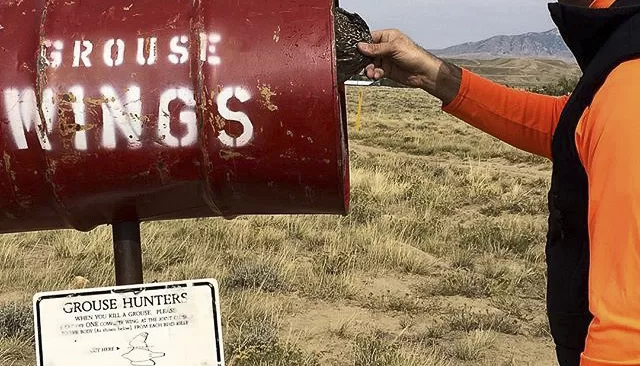
Its physical appearance was striking. It had a mottled, brownish-gray body with white chest feathers. Its specialized head feathers and long black tail feathers with white tips distinguished it from a female. I had shot a big male. Later, while at a Wyoming Game and Fish Department Sage Grouse Checkpoint, I would learn the bird was approximately a two-year-old “bomber” based on the measurements of the wings and other identifying male features. I raised the gray bird and set it on the tailgate. From my pack I retrieved a pair of sharpened game shears. The wings were spread out. The primary feathers were brown in color, and the undersides were white. The right wing was removed by cutting it off at the joint as close to the body as possible.
I returned the sage grouse to its resting place in my bird vest. I walked to the barrel with the stenciled words “GROUSE WINGS” spray-painted in white on both sides. Below the barrel a sign with specific instructions for hunters to follow. Wyoming Game and Fish biologists have placed marked barrels at convenient locations in the field and near major access roads to popular hunting areas along highways. I placed the sole wing into the dark opening of the red container and walked away. What sort of information would be obtained from my sage grouse?
The number of sage grouse wings submitted depends mainly on the cooperation of hunters. Bird hunters who voluntarily deposit wings help biologists obtain valuable information. Personnel specifically look at the ninth and tenth primary feathers on each wing to determine gender. Shorter feathers would show that the sage grouse was a juvenile, born in the spring. The number of juvenile and female birds in the wing count give an idea of the sage grouse reproductive success. Hen feathers tell if there was success in raising a brood. Female sage hens that show signs of finished molting when killed are a good indication the brood was lost, which freed up energy to go into molting. On the other hand, wings that show a slower molting pattern indicate the hen spent the summer raising her brood. Wing data from harvested sage grouse are especially valuable in wet years, where the birds are spread out more across the landscape, making it harder to get a good sample on brood sizes. Researchers know that brood success combined with lek-count data from specific areas, such as places with recent prescribed burns, has led to areas closed to hunting to help sage grouse populations recover.
THE IMPORTANCE OF WING COLLECTION: SURVEY SAYS…
The importance of wing collection is vital towards the continued understanding of both upland birds and waterfowl, especially those birds that benefit from such retrieved information (sage grouse and lesser prairie chicken). Unlike pheasants, which are easily counted during roadside surveys, determining the reproduction of grouse and other game birds and providing a fall forecast to hunters is not as easy. State and federal agencies each do their part in conducting surveys through wing collection to better determine populations and set and evaluate hunting seasons and limits. Population gauge aside, the wing count also acts as an informal report card for agencies.
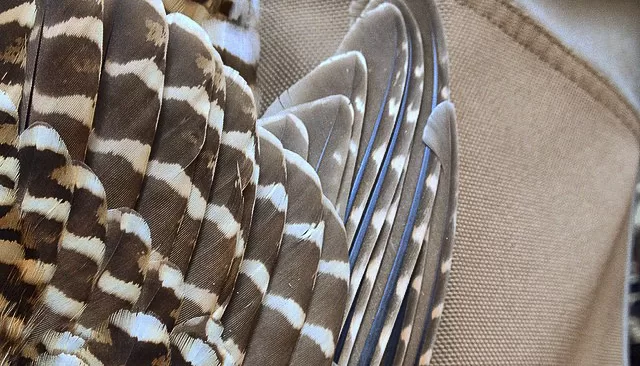
Greater Prairie Chicken Wing
The US Fish and Wildlife Service conducts the largest part of wing collection (dove, waterfowl, and woodcock) known as the Migratory Bird Parts Collection Survey. Wing surveys or wing-bees, as they are known, provide detailed information about the harvest. If participating in the federal survey, postage-paid wing envelopes are sent to randomly chosen hunters to send in their wings and parts to one of four collection points, one in each flyway. When the wings/parts arrive, they are sorted by species and stored in a freezer. The wings are then carefully reviewed for color, size, and shape of the feathers. Collected data are then entered into the national database for use in harvest management considerations.
Across the country in different regions, wing collection boxes or barrels are set up by various agencies and organizations (Ruffed Grouse Society, for example) for deposits from band-tailed pigeons, dove, grouse (blue, dusky, prairie chickens, ruffed, sage, sharp-tail), ptarmigan, snipe, and woodcock. Typically, hunters are asked to provide one wing from each bird taken.
An example would be the US Forest Service’s request of hunters in the Fort Pierre National Grasslands to provide a wing of each greater prairie chicken or sharp-tailed grouse shot. Collected wings help form a general idea of population conditions for upland birds in the grasslands. These chicken and sharp-tail wing counts are crucial, as they are umbrella or indicator species, along with prairie dogs. Their health and population numbers are suggestive of how animals who share similar habitats are faring. If these prairie grouse are doing well, it can be assumed other species are, too.
MORE THAN WINGS
Some states conduct wing surveys and other miscellaneous parts collections to gain a better understanding in upland bird populations. The state of Washington requests that forest grouse hunters help by voluntarily depositing wings and tails of shot birds into collection barrels. This helps with species that are remote and difficult to study.
Alaska launched a wing collection program in 2013 to gain insights into the state’s four species of grouse and three ptarmigan species. Hunters are asked to provide one grouse wing and tail, and one ptarmigan head and wing. The additional parts are yet another component and tool in identifying specific data such as sex, age, and also help evaluate populations. Biologists know that most grouse are harvested between the first part of the season (early to mid-August) and Thanksgiving. After that bird hunters tend to switch to hunting ptarmigan in the winter. This data helps determine harvest compositions to which biologists use to better understand distribution and how harvest changes over areas and time, informing management decisions such as seasons and limits.
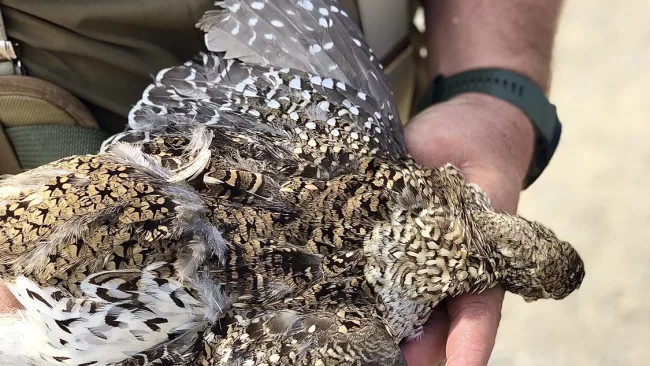
Sharp-tailed Grouse
Oklahoma researchers go as far as requesting hunters voluntarily donate one wing, preferably the right wing and the crop or crop contents of harvested quail (bobwhite and scaled quail). This helps in identifying WMA-specific (wildlife management area) fall and winter food sources and provides a broader picture of how quail use WMAs.
And of course, a wing survey wouldn’t be complete without a state requesting hunters to donate ruffed grouse wings. Cooperation between the New Hampshire Fish and Game and the New Hampshire Ruffed Grouse Society Chapter allows for an annual grouse wing and tail survey to be conducted throughout the state.
Samples provided by hunters allow biologists to determine age and sex composition, distribution data, and juvenile-to-adult female ratios. This information is critical about ruffed grouse and helps in determining populations and cyclic trends.
OTHER GAME BIRDS THAT WOULD BENEFIT FROM WING SURVEYS
Wilson’s snipe, sora rail, clapper rail, king rail, and Virginia rail–these five species are difficult to monitor because of their secretive habits, cryptic coloration, infrequent vocalizations, and use of difficult-to-access dense wetland habitats. Population sizes, and trends in abundance, are essentially unknown for snipe and rails at the flyway and national levels.
Harvest estimates are available for snipe and rails through the Migratory Game Bird Harvest Information Program (HIP), but annual harvest management decisions are made with considerable lack of information. At the moment, the Parts Collection Survey (PCS) for rails and snipe enables estimation of the species composition of the rail harvest and the age ratio of the snipe harvest. Wings collected as part of the PCS could be used for additional purposes to better inform management of these species.
Other uses for the wings include: (1) developing methods to age rail wings, (2) determining the spatial origin of the harvested rails and snipe, and (3) further assessing the species composition in the harvest. Surveys do not exist for rails and snipe. Surveys or wing-bees such as those for other species (i.e., doves, waterfowl, and woodcock), do not exist for rail and snipe. One possible solution would be to hold a rail and snipe wing-bee/survey in conjunction with the annual woodcock wing-bee.
THE REASON TO “WING IT” – PRESERVING THE OPPORTUNITY FOR FUTURE GENERATIONS
Data from the collection of wings can be used by biologists to better understand the distribution and the timing of game bird harvests in specific areas, the relative proportions of harvested birds, and the sex and age structure of game bird populations. Distribution and timing of harvest has relevance to obtaining information pertaining to game bird populations and trends, season structure, and to hunter participation for coordinating law enforcement activities.
Collections of game bird wings from volunteering hunters is a reasonably low-cost method in obtaining valuable information such as demographic profiles of game bird populations, overall health of species, and correlating habitat in specific areas. Consistency in wing collections is important in comparing harvest and hatch dates, and age and sex ratios between areas and years.
That is why there is a need to continue education efforts to increase hunter awareness and participation in returning wings, tails, and other requested parts. These efforts should emphasize the need for hunters to voluntarily drop wings off in identifiable boxes and barrels.
So if you’re a bird hunter and want to do your part, I recommend volunteering a wing or two (or tails) from harvested birds in the name of science. This is especially true when hunting those birds that are on a fine line of being accessible to hunt, e.g. the sage grouse. By committing a wing, hunters are in a sense preserving future hunters’ opportunity to hunt upland birds and waterfowl. Hunters going into an area can contact DNR offices and obtain information as to whether or not the area is participating in wing collection. Some agencies provide wing box locations via their website to better help hunters locate drop-off boxes. Once the decision is made to drop a wing off at a collection site, after that it’s relatively easy. Hunters just need a good sharp knife or pair of game shears.
